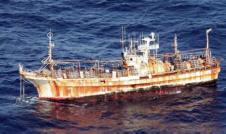
The shrimping vessel, which has no lights or communications
systems, was floating about 195 miles south of Sitka in the Gulf of Alaska on
Thursday morning, traveling about 1 mile per hour.
Authorities are
concerned it could interfere with the course of other vessels as it drifts
through shipping lanes.
Last Thursday a Coast Guard cutter sank the ship with cannons loaded with high explosive rounds. If left to drift, the ship would ground somewhere.
On-board are more than 2,000 gallons of diesel fuel which prompted the National Oceanic and Atmospheric Administration and the Environmental
Protection Agency to study the problem and ultimately decide it is safer to sink the ship
and let the fuel evaporate in the open water.
The Coast Guard will observe from
an HC-130 Hercules airplane.
The vessel, named Ryou-Un Maru, is believed to be 150 to 200 feet long. It has
been adrift from Hokkaido, Japan, since it was launched by the tsunami caused by
the magnitude-9.0 earthquake that struck Japan last year. About 5 million tons
of debris were swept into the ocean by the tsunami.
The Japan earthquake triggered the world's worst nuclear crisis since the
Chernobyl accident in 1986, but Alaska state health and environmental officials
have said there's little need to be worried that debris landing on Alaska shores
will be contaminated by radiation. They have been working with federal
counterparts to gauge the danger of debris including material affected by a
damaged nuclear power plant, to see if Alaska residents, seafood or wild game
could be affected.
In January, a half dozen large buoys suspected to be from Japanese oyster farms
appeared at the top of Alaska's panhandle and may be among the first debris from
the tsunami. |
|
 |
|
Worldwide Travel & Cruise Assoc., Inc.
150 S. University Dr. Ste E,
Plantation, FL 33324 - USA
Tel: +1 954 452 8800 Fax: +1 954
252 3945
EMail:
sales@cruiseco.com |






